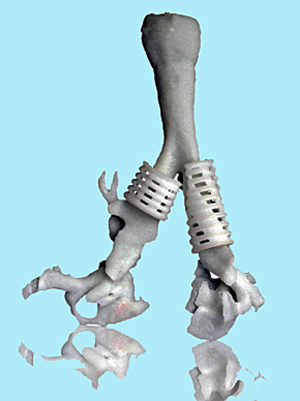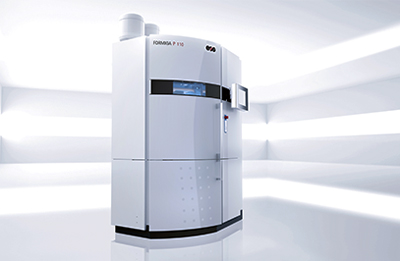Biocompatible Polymer 3D-printed into Lifesaving Medical Implants
Michigan and EOS partner to additively-manufacture trachea from polymer. Other implants now in development.
Two of Michigan's groundbreaking 3D printed tracheal splints.
An adolescent girl has now joined a group of three baby boys and a baby girl who have received 3D-printed tracheal splints to treat a congenital breathing condition called tracheobronchomalasia (TBM). It is estimated that one in every 2,000 children is affected by this life-threatening condition worldwide. A partnership between University of Michigan and 3D priniting specialist EOS developed the life-saving implants.
All five patients are progressing well thanks to the surgical procedures that have helped their collapsed airways function normally. The lifesaving procedures were conducted under US Food & Drug Administration Emergency Clearance. Additive manufacturing specialist company EOS provided technology solutions and expert.
Dr. Glenn Green, a pediatric otolaryngologist, and his surgical team from C.S. Mott Children's Hospital, Ann Arbor, MI, joined forces with Dr. Scott Hollister, professor of biomedical engineering at the University of Michigan, to pioneer these patient-specific designs. “It's now pretty automatic to generate an individualized splint design and print it; the whole process only takes about two days now instead of three to five," said Dr. Hollister. However, there were some challenges to overcome in achieving this success.
How did the relatively small university team create surgery-ready implants on an academic research budget? Computer-aided design (CAD) sped up the engineering side and 3D printing provided cost-effective, patient-specific production. “Even if a market is relatively small, this doesn't diminish the human need to be treated," says Dr. Hollister, who first learned about additive manufacturing in the 1990s. “Later, when I started designing my own porous scaffolds for anatomical reconstruction, I realized that 3D printing would be useful for creating the complex geometries I had in mind."
Polycaprolactone (PCL) was found to be the perfect material for additively manufacturing a tracheal implant: Firstly, this biodegradable polyester with a low melting point of around 60°C, has a long resorption time, which is important in airway applications, because the implant needs to remain in place for at least two years before it is resorbed. Secondly, PCL is very ductile, so if it degrades, it does not release particles that could puncture tissue. Thirdly, PCL can be readily processed for, and fabricated on, the EOS system.
Implant printer: EOS's Formiga P 100 system.
Solution
Dr. Hollister and the University of Michigan had already purchased an EOS Formiga P 100 system in 2006 to aid research into scaffolds and biomaterials. “We chose EOS because we were looking for a system that was flexible and allowed us to change parameter settings like laser power, speed, powder-bed temperature, and so on, which we needed to do to customize our builds," says Dr. Hollister. “Also, because biomaterials can be expensive and implants and scaffolds are typically not so big, we wanted a more limited build volume that didn't use a lot of material. The Formiga P 100 fitted the bill for both of these requirements."
Additive manufacturing expertise was provided by EOS, which helped the team on site in their laboratory, advising them on how best to prepare the material for production. The company offers a wide variety of proprietary plastic and metal materials, but the use of PCL was a first in this case. “We make a point of being very open in terms of materials. We support universities in the development of their own parameters for novel materials on EOS systems, such as in this instance with the University of Michigan," said Martin Bullemer, Business Development Manager Medical at EOS.
The Michigan team uses patient data from MRI or CT scans to examine the defect to be repaired, then creates computer models of the anatomy. Engineers are then able to design splints with a porous structure of interconnected spaces, which will slowly expand along with the maturing airway over time. “EOS even gave us access to software patches, to enable us to change the range of parameters of the machine to best process the PCL material,” said Dr. Hollister.
The splint was produced using the Formiga P 100 system. “Additive manufacturing is one of the few methods I know that allows us to fabricate these complex designs," said Dr. Hollister. After fabrication, the researchers measure the splint dimensions and then mechanically test them. The splint-supported trachea expands and is operational right away, so that when patients are weaned off oxygen, they are able to breathe normally. The first child recipient of the device s now nearly four years old and now an “active preschooler”, according to the team. As planned, the boy's own tissues have successfully taken over the job of the implant, which has been almost completely reabsorbed into his body.
Other parts in development
Dr. Hollister's group is also developing craniofacial, spine, long bone, ear and nose scaffolds and implants—and producing them all using Additive Manufacturing technology from EOS, using a material with characteristics that promote reconstruction and regrowth following birth defects, illnesses or accidents. While 3D printing is being adapted to serve an ever-widening breadth of industrial applications, it is this kind of clinical translation of the technology to individual patient-specific solutions that is making life-altering history in the field of medicine.
Dr. Green says that his office is continually receiving phone calls and emails from parents and doctors enquiring about these implants. The future role of Additive Manufacturing in the medical field is clearly wide open, Dr. Hollister believes. “I see a time soon, probably within the next five years, when many hospitals and medical centers will print their own devices specifically for their own patients, and not need to get them off-the-shelf."
(From: http://optics.org/news/7/3/21)


